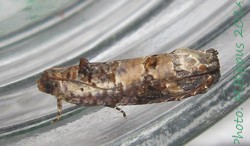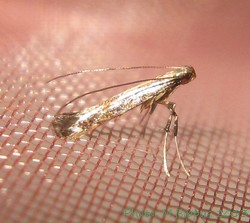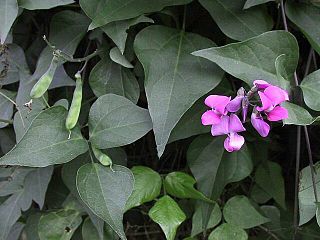Eucoenogenes ancyrota is a moth of the family Tortricidae. It is found in India, Sri Lanka, Japan, Korea, Burma, Thailand, western Malaysia and Brunei.
Cydia leucostoma, the tea flush worm, is a moth of the family Tortricidae. It is found in India, Sri Lanka, Taiwan and Indonesia.

Sphenarches anisodactylus, commonly known as the geranium plume moth, is a species of moth in the family Pterophoridae. It is found in western Africa, Madagascar, India, Sri Lanka, Thailand, Japan, the New Hebrides and Central and South America, as well as Australia, where it has been recorded from Cape York to central New South Wales. It is found in the United States, where it has been recorded from Florida, as well as Mississippi. It is also present in the Kermadec Islands of New Zealand.

Bactra venosana, the nutgrass borer or nutsedge borer, is a moth of the family Tortricidae. It was first described by Philipp Christoph Zeller in 1847. Julius von Kennel provides a full description. It has a wide distribution, from southern Europe, North Africa and Asia Minor to India, Sri Lanka, southern China, Malaya, Australia and into the Pacific where it is found on Java, Borneo, the Philippines, Taiwan, Timor, the Solomons, the Carolines and Fiji. It was introduced to Hawaii in 1925 to control nutsedge. It is now found on Kauai, Oahu, Molokai, Maui, Lanai and Hawaii.
Adoxophyes privatana, the appleleaf-curling moth, is a moth of the family Tortricidae. The species was first described by Francis Walker in 1863. It is native to south-east Asia, where it has been recorded from Taiwan, Hong Kong, Hainan in China, Nepal, India, Sri-Lanka, Thailand, Vietnam, western Malaysia, Singapore, Sumatra, Java, Borneo, the Philippines and the Chagos Archipelago. It is an accidental introduction in Great Britain.

Dudua aprobola, the mango flower webworm or litchi leaf roller, is a moth of the family Tortricidae. The species was first described by Edward Meyrick in 1886. It is a pest on several economically important crops.

Phodoryctis caerulea is a moth of the family Gracillariidae. It is known from India, Malaysia (Sabah), Indonesia (Java), Sri Lanka, Fiji, Guam, the Solomon Islands, Japan and Taiwan, as well as Madagascar, Mauritius, Réunion, Uganda and Tanzania.
Caloptilia soyella is a moth of the family Gracillariidae. It is known from Cape Verde, China, Fiji, India, Indonesia (Java), Japan, Sri Lanka and Vietnam.

Tiracola plagiata, the cacao armyworm, is a moth of the family Noctuidae. The species was first described by Francis Walker in 1857. It is found from south-east Asia, South India, Sri Lanka, Myanmar to the South Pacific Islands, including the northern two-thirds of Australia.

Lobesia aeolopa is a moth of the family Tortricidae first described by Edward Meyrick in 1907. It is found in Vietnam, Thailand, India, Sri Lanka, Myanmar, Java, the Solomon Islands, Korea, Japan, Taiwan, São Tomé and Príncipe, Tanzania, South Africa, Réunion and Madagascar.
Sorolopha archimedias is a moth of the family Tortricidae first described by Edward Meyrick in 1912. It is found in Thailand, China, Sri Lanka, India, Java and Queensland, Australia.

Homona coffearia, the tea tortrix or camellia tortrix, is a moth of the family Tortricidae. The species was first described by Nietner in 1861. It is widely distributed in the Oriental region.

Dipogon lignosus, the okie bean, Cape sweet-pea, dolichos pea or mile-a-minute vine, is a species of flowering plant in the legume family, Fabaceae. It is the only species classified in the monotypic genus Dipogon which belongs to the subfamily Faboideae.
Phricanthes flexilineana is a species of moth of the family Tortricidae first described by Francis Walker in 1863. The species was described from Sri Lanka, northern Queensland in Australia and the Seychelles, but has a much wider range, which includes Madagascar, India, Indonesia, Myanmar, New Guinea, the Philippines and Taiwan. It is also widely distributed in the tropical parts of North and South America.

Diceratura ostrinana is a species of moth of the family Tortricidae. It is found from Algeria and the Iberian Peninsula to Hungary, Albania and the Crimea. It is also found in Asia Minor, Lebanon, Transcaucasia, Siberia and Iran.
Homona encausta is a species of moth of the family Tortricidae first described by Edward Meyrick in 1907. It is found in Sri Lanka, Luzon in the Philippines and Vietnam.
Acleris extensana is a species of moth of the family Tortricidae first described by Francis Walker in 1863. It is found in Sri Lanka, India, China and Vietnam.
Brachiolia egenella is a species of moth of the family Tortricidae first described by Francis Walker in 1864. It is found in Sri Lanka, India, South Africa and on the Comoros and Mauritius.

Pammene critica, the redgram webber or leaf webber, is a moth of the family Tortricidae. The species was first described by Edward Meyrick in 1905. It is found in India and Sri Lanka.
Heleanna physalodes is a moth of the family Tortricidae first described by Edward Meyrick in 1926. It is found in the Chagos Archipelago, Sri Lanka, Guam, Micronesia and Fiji.










